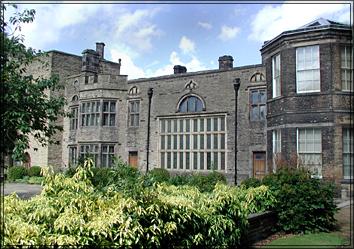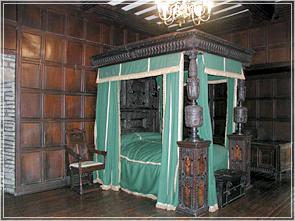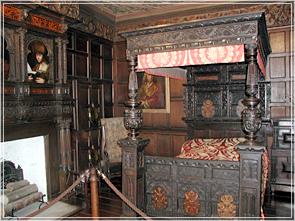Yorksview

| When you think of Bradford, images of sprawling run-down terraced houses spring
to mind. But, tucked away in a leafy garden and less than a mile from the city
centre, is one of Bradford's most precious jewels - Bolling Hall, a beautiful
15th century stone house. Bolling Hall was first mentioned as far back as the Domesday Book (1086) owned by someone named Sindi. The house then being worth just five shillings annual rent (25p in today’s money). It later passed into the hands of the de Laci family. Ilbert de Laci was granted the land by William the Conqueror for his services in the battle of Hastings. |
|
|
|
No records show how long the de Laci family owned the Hall, or what changes were
made to it. However, after the reference in the Domesday Book, the next recorded
owner was William Bolling in 1316, so we can assume that the de Laci family
owned the Hall for 230 years. Records show that the Bolling family increased their wealth and accumulation of land during the C13th and C14th, and by the C15th were an important family in the West Riding of Yorkshire. |
| It was during the War of the Roses that Robert Bolling temporarily lost Bolling
Hall, his land and manor houses were forfeited to the crown, (Edward IV). This
was his punishment for fighting for the Lancastrians, his life only being spared
by pardon of the King. Robert Bolling lived with his wife and 10 children in impoverished circumstances and it wasn’t until 1472 (some 11 years later), he asked for the return of his lands, claiming that he had fought in the battle against his will. Robert Bolling commanded the support of the Duke of Gloucester, and on the back of the petition (now in the Public Records Office), is the endorsement of the Duke of Gloucester, who was later to be crowned King Richard III. |
|
|
|
The Hall was now safely back in the possession of the Bolling family. On the death of
Robert Bolling in 1537, his son Tristram inherited the estates. He later married
Beatrice Carverley and they had one child, Rosamund, who on her marriage to Richard
Tempest in 1497 received Bolling Hall and the lands as part of her dowry. On the
death of her father she inherited the estate. Thus Bolling Hall passed to the
Tempest family. Richard Tempest died in prison in 1537 whilst awaiting trial for taking part in the Rebellion of the Gentry in 1536. Rosamund Tempest carried on with the running of the estate until her death in 1553. |
The Hall still remained in the Tempest family, as her son Sir John Tempest
succeeded to the estate. On his death, the estate passed to his brother
Nicholas. By the time Nicholas’ grandson, another Sir Richard Tempest, inherited
the estate, the family fortune was dwindling, and in 1620 he sold the manors of
Thornton and Clayton. Sir Richard died in 1639 and his son Richard was the last
Tempest to own the Hall.
The Bolling Hall Ghost
One of the bedrooms at the Hall is known as 'The Ghost Room'. Nobody
within living memory has actually seen a ghost there, but there is a story that
one appeared there many years ago.
The Civil War raged up and down the country during 1642 - 1644. Bradford's first
real brush with the War was in December 1642. The town was strongly Puritan, the
local people valuing their right to read and discuss the Bible as they chose and
to worship as they saw fit. The town was generally sympathetic to Oliver
Cromwell and his idea that Parliament, not just the King, should have the final
say in all matters of law.
Bolling Hall then stood outside the town, with a commanding view over the whole
of it towards the Parish Church and the main streets of Ivegate and Kirkgate.
The owner, Sir Richard Tempest, belonged to the old school who believed that the
King alone had the right, received directly from God, to rule as he wanted and
that Parliament should be lower. Sir Richard was therefore a Royalist.
| The town of Bradford was besieged by the Royalist army, under the Earl of
Newcastle, in December 1642. The Earl of Newcastle stayed with Sir Richard
Tempest, and looked down on this small town from the hill above it. Bradford
held out strongly, in spite of having no army and no fortifications, and the
Earl's temper was naturally not improved by this. No one knows for sure which room the Earl occupied here, but it may have been the small chamber over the parlour, with its grand bay-window and fine painted plaster ceiling. The story tells that he was very angry one Sunday evening at Bradford's continued resistance and, as he went to bed, declared that the following morning he would slaughter every man, woman and child in the place - in spite of this being against the general code of conduct for war. He then slept. |
|
During the night the Earl was woken by the sensation of his bedclothes being
pulled from him. At the side of his bed stood the ghostly figure of a woman,
wringing her hands and sobbing 'Pity Poor Bradford!'. The
following morning the Earl was suitably shaken and said that he had changed his
mind. He would still attack Bradford, but would now only seek to slaughter those
who offered real armed resistance. Bradford was duly attacked and taken by the
Royalists. There were very few casualties, probably less than ten, who died of
wounds received in the skirmishing.
20 years ago Bradford's local newspaper offered a reward of £50 to anyone who
would stay in the Hall overnight. The offer was never taken up.
Today Bolling Hall is owned by
Bradford Council, and is used as a Museum and Education centre for school
children. The house has been restored, and a fine collection of 16th and 17th
century furniture, along with a bed made by Thomas Chippendale for Harewood House. A
collection of paintings from Bradford Museum by English artists including
Reynolds, hang on the walls.
The Hall is peaceful and brimming with interest. Visitors of all ages are
fascinated by the intricate carvings on the old oak furniture, by the heavily
curtained beds, by the blood stain on the floor, by the Boar's head on the wall
quite properly without a tongue, and of course by Bradford's most famous ghost.




